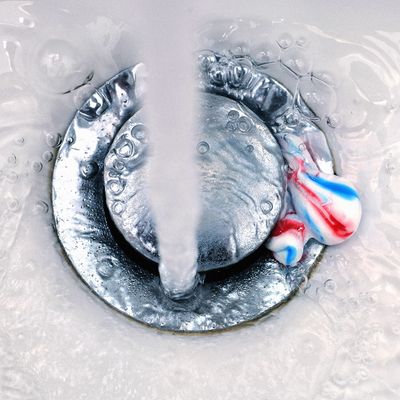Do We Really Need to Be Worried About Fluoride in Tap Water?

Photo: Getty
Distrust of fluoridated water — long-considered the only reason some Americans still have teeth — was already growing before RFK Jr., Trump’s pick to chair the Department of Health and Human Services, tweeted that Trump would move to eliminate it from America’s drinking water as soon as he took office. Recent anti-fluoride activism stems largely from a number of studies suggesting that high fluoride levels may damage the nervous system. In September, a federal judge even ruled that the Environmental Protection Agency must reassess its fluoride regulations, acknowledging a potential risk to children’s intellectual development. But the push to stop fluoridating water also underscores broader shifts: growing mistrust in public-health systems, mounting worries about forever chemicals, and a widening movement to upend long-standing public-health policies and instead place the onus of health care on citizens — and especially in the case of children’s dental health, on parents.
So is fluoridated water actually a danger to public health or is RFK Jr. just feeding the public another vaccine-like conspiracy theory? Here’s what you need to know.
Fluoride is a mineral that naturally occurs in soil, water, and rocks. Dentists have known that it helps to strengthen teeth and reduce the likelihood of developing cavities since the 1940s. When fluoride comes into contact with tooth enamel, it repairs the decay wrought by acidic and mineral-dissolving bacteria and strengthens the outer layer of the tooth, says Jennifer Webster-Cyriaque, D.D.S., Ph.D., deputy director of the National Institute of Dental and Craniofacial Research.
Many toothpastes have fluoride in them, but most mouthwashes (including ones from Listerine and Colgate) do not, unless the product is specifically labeled as a fluoride rinse. Fluoride can also be found in concentrated gels and foams that dentists paint on teeth during cleanings. Then, of course, there’s the fluoride in water: Almost all water naturally contains a little fluoride, usually at levels too low to prevent cavities. But almost 75 percent of the U.S. population (approximately 221 million people) is currently served by a fluoridated community-water system — that is, water with added fluoride. For the average person with fluoridated tap water in their home, about 75 percent of their annual fluoride intake comes from drinking tap water or soda or fruit juice made with fluoridated water.
The CDC has set the concentration for fluoridated water at 0.7 milligrams of fluoride per liter of water, which is about equal to three drops in a 55-gallon barrel. But that hasn’t always been the concentration. In 2015, officials lowered the recommendation for drinking-water fluoride levels to address fluorosis, a condition that can cause spotting and discoloration on teeth. From 1962 (when standards were first adopted) to 2015, the recommended level was a range: from 0.7 to 1.2 milligrams per liter.
The public-health measure goes back nearly 80 years when researchers noticed that people who lived in regions with naturally high-in-fluoride water had fluorosis but also far fewer cavities. In 1945, Grand Rapids, Michigan, became the first American community to add fluoride to its water supply. (And even then, there was burgeoning resistance to it, with some linking the effort to Communism.) But the immediate benefits to dental health were huge, says Richard W. Valachovic, D.M.D., M.P.H., executive director of the Center for Oral Health Policy and Management at NYU School of Dentistry. “When fluoridation was first introduced in the 1940s and 1950s, communities saw significant declines in tooth decay, sometimes up to 60 percent among children, compared to non-fluoridated areas.”
However, that reduction became less significant after the widespread introduction of fluoridated toothpastes and other dental products in the mid-1970s. More recent research suggests that communities with optimally fluoridated water experience approximately 25 percent fewer cavities compared to non-fluoridated communities. Another study has found that adding fluoride to water reduces the amount of tooth decay in young kids by 35 percent. According to the American Dental Association, for most municipalities, every $1 invested in water fluoridation saves Americans $38 in dental-treatment costs. Dr. Junhewk Kim, an assistant professor at Yonsei University College of Dentistry in Seoul and the author of a 2021 paper on fluoridation, says the return on investment for the CDC is about $20 for every $1 spent on fluoride. “As a community health measure, water fluoridation is highly cost-effective,” he says.
In 1999, the CDC named community fluoridation one of ten great public-health achievements of the 20th century.
Beyond RFK Jr.’s newly expanded platform, in August 2024, the National Toxicology Program released a monograph that analyzed a number of studies and concluded that fluoride levels in drinking water exceeding 1.5 milligrams per liter are associated with lower IQ scores in children. This finding aligned with earlier studies, such as a 2019 meta-analysis by Harvard researchers published in Environmental Health Perspectives, which also reported a link between high fluoride exposure and reduced cognitive development in children. All together, “these studies suggest that elevated fluoride levels may adversely affect neurodevelopment, raising concerns about the safety of current fluoridation practices,” says Valachovic.
In response, some experts and an increasing number of laypeople contend that the line between safe and unsafe fluoride levels is just too thin, especially given the stakes (children’s intellectual development) and emerging research on pregnant women and adults. “The recent ruling against the EPA stated that there isn’t enough of a margin of safety between the level of fluoride that is targeted for dental caries and the fluoride level that has been consistently associated with reduced IQ in children,” says Ashley Malin, Ph.D., an assistant professor of epidemiology at the University of Florida, who has studied the effect of higher fluoride levels in pregnant women and on their children.
Currently, Portland, Oregon, is the largest city in the U.S. that does not fluoridate its tap water. The lack of fluoride in its water forces parents to stick to regular dental visits for their children and carefully use additional fluoride products at home — measures that are not easy to implement in areas with limited access to professional dentists. “Fluoridation benefits everyone in the community, regardless of income, education, or access to dental care, helping to close the gap for underserved populations who may have limited access to fluoride toothpaste or professional dental visits,” says Valachovic.
The World Health Organization states that a safe level of fluoride in drinking water is 1.5 mg/L — more than double the U.S. Public Health Service recommendation. “This standard was established specifically to optimize dental-health benefits while maintaining a substantial margin of safety below potentially problematic levels,” says Kim.
Major health organizations, including the CDC, the National Institutes of Health, the ADA, and the American Academy of Pediatrics, continue to endorse water fluoridation as a safe and effective measure for preventing tooth decay. They argue that the benefits of fluoride in dental health outweigh the potential risks, especially when exposure is kept within the recommended limits. “The general public should not be concerned,” says Valachovic, “as the fluoride levels in regulated water supplies are carefully monitored and adjusted to be well below levels associated with potential harm.”
The economist Emily Oster, who has developed a niche analyzing health data and helping parents make sensible decisions from it, recently used the expression “the dose makes the poison” when it comes to fluoride. “That adage is particularly relevant when discussing fluoride,” says Valachovic. “Fluoride, like many other substances — even water and vitamins — is beneficial at appropriate levels but can be harmful when consumed in excessive amounts.”
What Trump and Kennedy will do in office remains to be seen. Regarding banning fluoride, Trump told NBC News: “It sounds okay to me, you know, it’s possible.” But it’s worth noting that the EPA, not HHS, has jurisdiction over fluoride. (Trump has nominated former Long Island congressman Lee Zeldin to lead the EPA, and Zeldin, to our knowledge, has never commented publicly on fluoride.) And even then, the EPA’s role is limited. The agency can provide guidance at the federal level, but, says Valachovic, “decisions about community-water fluoridation are made at the state or local level, depending on the state.”
Mayor Eric Adams initially deflected questions about whether or not he’d go with the Trump/Kennedy stance on fluoride, stating that he “deferred to experts at the New York City and New York State health departments.” Later, his spokeswoman said: “Mayor Adams supports keeping fluoride in New York City’s water supply as recommended by his public-health officials and experts.” According to the New York City Department of Environmental Protection, the NYC water supply is monitored hundreds of times each day, 365 days a year.
If you are worried about the fluoride levels in the water in your area, you can check them on the CDC’s My Water’s Fluoride webpage. (Not all states participate; local environmental departments can also give you the information.) And if you’re concerned about your own fluoride exposure, you may want to consider a reverse-osmosis home-water purifier, which filters out fluoride entirely. (This one is Erin Brockovich’s favorite.) You’ll need to talk to your dentist (and if you have kids, their pediatrician) about whether using fluoride toothpaste at home is sufficient to protect your teeth from cavities or if you’ll need in-office fluoride treatments as well.


